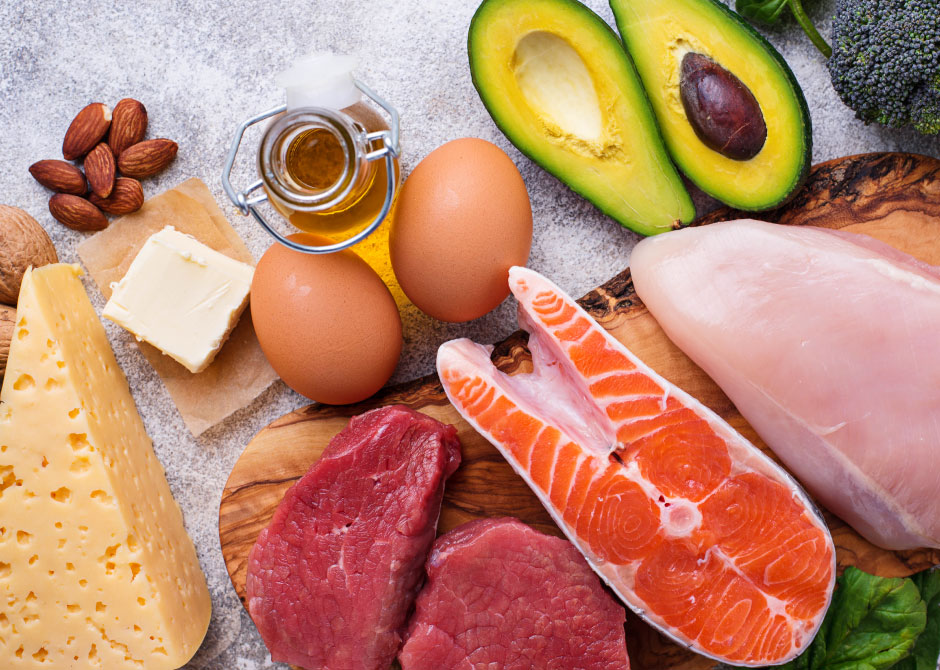
Get to Know Keto
With summer around the corner, many of us are extra motivated to shed the lingering winter weight, but with so many fad diets circulating online and in the news, it’s hard to discern healthy weight loss solutions from media hype that could leave your metabolism in shambles. To help beat the blab, our team of registered dietitians answered some burning questions about one of the biggest wellness trends of this season: the Keto Diet.
Q: What is the Ketogenic Diet?
A: A ketogenic diet is a low-carb, moderate-protein and high-fat diet that puts the body into a metabolic state of ketosis, a process in which the body burns fats as an alternative fuel source to carbohydrates. Reaching a state of ketosis where the body starts to break down fat as fuel usually takes the average person 2-5 days. A ketogenic diet is a great way to accelerate weight loss; however, like any diet that restricts macronutrients, it is not a recommended sustainable nutritional plan.
Q: How long has the ketogenic diet been around?
A: The ketogenic diet is not new. In fact, it was initially developed more than 100 years ago as a drug-resistant treatment for epilepsy, particularly in children. Later, there was a modified revival of the keto diet by Dr. Atkins, who pioneered popularity in ultra low-carb diets, including an initial two-week ketogenic phase.
Q: What’s the nutritional breakdown of a typical day?
A: As with most diets, people are most concerned with what they are allowed and not allowed to eat while on the plan. A typical day of food for someone on the Ketogenic Diet means aiming to keep net carb intake under 25 grams. You can find the total net carbs of a food by subtracting the total grams of fiber from the total carbohydrates. It’s also important to track your daily protein, fat and calorie consumption. Below is a helpful breakdown showing the amount of net carbs, proteins and fats in an example 1,800 calorie diet. Remember, these numbers need to be tailored depending on the person, lifestyle factors and nutritional needs of their body.
Example: 1,800 Calorie Per Day Diet
- 20 grams of net carbohydrates
- 90 grams of protein
- 150 grams of fat
Q: What can I eat?
A: One of the best things about the ketogenic diet is that it allows you to feel like you’re eating A LOT. However, typical Keto diets must consist of the following sources of protein, fat and micronutrients:
- Sources of protein: Meat, poultry, seafood, bacon, eggs and nuts
- Sources of fat: Avocado, coconut milk/oil, olive oil, nut/nut butter, butter, mayonnaise and cheese
- Keto approved vegetables: Broccoli, asparagus, spinach, celery, tomatoes, peppers and mushrooms
Q: What can’t I eat?
A: With every diet comes some tough goodbyes. With the ketogenic diet, those goodbyes include carbs, starches and sugars—try to steer clear of foods like:
- Dairy (except high-fat cheese, butter and sour cream, those are permissible on the keto diet)
- Fruit: Bananas, pineapples, apples and grapes
- Grains: wheat, barley, oats and rye
- Beans/legumes: kidney beans, chickpeas and black beans
- Starchy veggies: Corn, potatoes, sweet potatoes and yams
- Semi-sweet veggies: Squash, beets and carrots
Q: Will the ketogenic diet really help me lose weight?
A: Research indicates there is faster initial weight loss for people on low-carb diets compared to more traditional diets, but the biggest perk of the keto diet is its ability to keep hunger at bay. The heavy reliance on fat and protein causes us to release more of the satiety hormones—meaning we feel good eating less. Keep in mind, the ketogenic diet is intended to jumpstart weight loss as you begin your journey toward a healthier lifestyle. It is not a long-term weight loss solution. When you resume eating carbs after being on the keto diet you may see some weight return. Don’t be disheartened! Carbs love water and for every one gram of carbohydrates you eat, you’ll also attract three grams of water.
Q: What are other benefits of the ketogenic diet?
A: Aside from weight loss, living a keto lifestyle has some other perks like:
- Improving blood sugar in those with type two diabetes
- Reducing seizures in children
- Lowering cholesterol
- Increasing oxygen availability during endurance exercises
- Promoting muscle growth
Q: Are there any downsides to the ketogenic diet?
A: It’s important to keep in mind that not all fats are equal. For example, chowing down on bacon wrapped pork rinds might be a good source of fast fats, but incorporating too many unhealthy fats into your diet could cause your bad cholesterol to skyrocket. Some other cons to the ketogenic diet can be:
- Difficulty maintaining over time
- Constipation
- Risk for certain vitamin deficiencies
Before starting a new diet or exercise plan, always consult your nutritional expert or doctor.
Let’s Go Keto!
Shop Keto-friendly foods online or in-store!
Ready for a Second Helping of Health and Wellness?
Check out our lookbook for an exclusive taste of health and wellness trends, brought to you by Market Street’s Registered Dietitians and lifestyle gurus.

